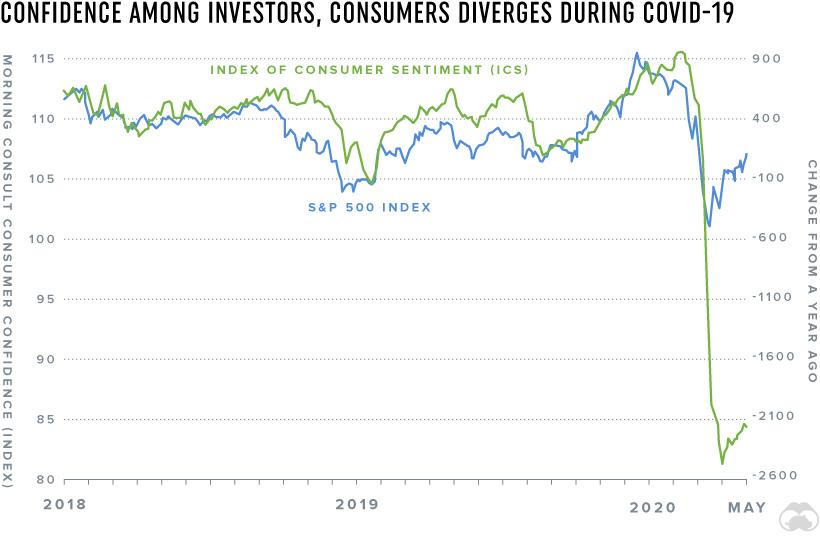Visualizing How US Consumers Are Spending Differently During
COVID-19 Tyler Durden
Tue, 05/26/2020 – 23:45
In 2019, nearly 70% of U.S. GDP was driven by personal
consumption. However,
as Visual Capitalist’s Iman Ghosh notes, in the first
and second quarters of 2020, the COVID-19 pandemic has initiated a
transformation of consumer spending trends as we know
them.
Consumer Spending in Charts
By leveraging new data from analytics platform1010Data, today’s
infographic dives into the credit and debit card spending of five
million U.S. consumers over the past few months.
Let’s see how their spending habits have evolved over that
short timeframe:
The above data on consumer spending, which comes from 1010Data
and powered by AI platform Exabel, is broken into 18 different
categories:
-
General Merchandise & Grocery: Big Box,
Pharmacy, Wholesale Club, Grocery -
Retail: Apparel, Office Supplies, Pet
Supplies -
Restaurant: Casual dining, Fast casual, Fast
food, Fine dining -
Food Delivery: Food delivery, Grocery Delivery,
Meal/Snack kit -
Travel: Airline, Car rental, Cruise, Hotel
It’s no surprise that COVID-19 has consumers cutting back on
most of their purchases, but that doesn’t mean that specific
categories don’t benefit from changes in consumer habits.
Consumer Spending Changes By Category
The onset of changing consumer behavior can be observed from
February 25, 2020, when compared year-over-year (YoY).
As of May 12, 2020, combined spending in all categories dropped
by almost 30% YoY. Here’s how that shakes out
across the different categories, across two months.
General Merchandise & Grocery
This segment saw a sharp spike in initial spending, as Americans
scrambled to stockpile on non-perishable food, hand sanitizer, and
toilet paper from Big Box stores like Walmart, or Wholesale Clubs
like Costco.
In particular, spending on groceries reached a YoY increase
of 97.1% on March 18, 2020. However, these sudden
panic-buying urges leveled out by the start of April.
Pharmaceutical purchases dropped the most in this segment,
possibly as individuals cut back on their healthcare expenditures
during this time. In fact, in an April 2020 McKinsey survey
of physicians, 80% reported a decline in patient
volumes.
Retail
With less foot traffic in malls and entire stores forced to
close, sales of apparel plummeted both in physical locations and
over e-commerce platforms.
Interestingly, sales of office supplies rose as many pivoted to
working from home. Many parents also likely required more of these
resources to home-school their children.
Restaurant
The food and beverage industry has been hard-hit by COVID-19.
While many businesses turned to delivery services to stay afloat,
those in fine dining were less able to rely on such a shift, and
spiraled by 88.2% by May 5, 2020,
year-over-year.
Applebees or Olive Garden exemplify casual dining, while Panera
or Chipotle characterize fast casual.
Food Delivery
Meanwhile, many consumers also shifted from eating out to home
cooking. As a result, grocery delivery services jumped by over
five-fold—with consumers spending a
whopping 558.4% more at its April 19, 2020 peak
compared to last year.
Food delivery services are also in high demand, with Doordash seeing
the highest growth in U.S. users than any other food delivery app
in April.
Travel
While all travel categories experienced an immense
decline, cruises suffered
the worst blow by far, down by 87.0% in YoY
spending since near the start of the pandemic.
Airlines have also come to a halt, nosediving
by 91.4% in a 10-week span. In fact, governments
worldwide have pooled together nearly $85
billion in an attempt to bail the industry out.
Hope on the Horizon?
Consumer spending offers a pulse of the economy’s health.
These sharp drops in consumer spending fall in line with the steep
decline in consumer confidence.
In fact, consumer confidence has eroded even more intensely than
the stock market’s performance this quarter, as observed when the
Index of Consumer Sentiment (ICS) is
compared to the S&P 500 Index.
Many investors dumped their stocks as the coronavirus hit, but
consumers tightened their purse strings even more. Yet, as the
chart also shows, both the stock market and consumer sentiment are
slowly but surely on the mend since April.
As the stay-at-home curtain cautiously begins to lift in
the U.S., there may yet be hope for economic recovery on the
horizon.
























